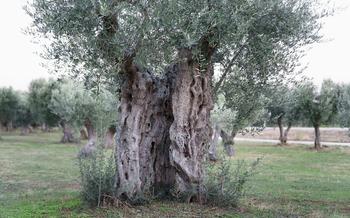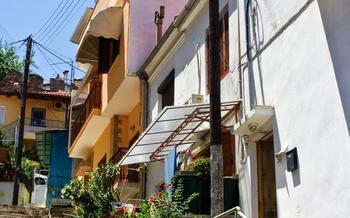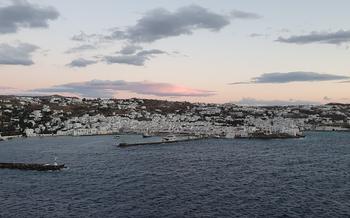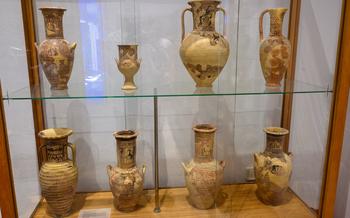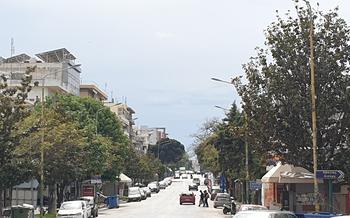
Ancient Maroneia
- Historical Background
- The City Walls
- The Agora
- The Theater
- The Sanctuary of Dionysus
- The Acropolis
- The Museum of Maroneia
- Festivals and Events
- Beaches and Natural Beauty
- Local Cuisine
- Accommodation and Amenities
- Getting There and Around
- Planning Your Visit
- Insider Tip
Historical Background
Maroneia, an ancient city in Thrace, boasts a rich history dating back to the 7th century BC. Founded by Greek colonists from the island of Chios, it quickly rose to prominence as a major port and trading center. Its strategic location on the Aegean Sea allowed it to flourish through trade with other Greek city-states and the wider Mediterranean world.
Maroneia's prosperity and influence grew during the Classical and Hellenistic periods. It became an important member of the Delian League, a maritime alliance led by Athens, and minted its own coins, a testament to its economic strength. The city's autonomy and democratic government allowed it to maintain its cultural identity and independence.
Maroneia's significance extended beyond its economic and political power. It was renowned for its cultural achievements, particularly in the arts and philosophy. The city was home to a vibrant intellectual community and produced notable scholars, poets, and artists who contributed to the wider Hellenic civilization.
The City Walls
The city walls of Maroneia were a testament to the city's strategic importance and its ability to withstand attacks. Constructed in the 4th century BC, the walls encircled the entire city, stretching for an impressive 5 kilometers. Built using large blocks of stone, the walls were up to 3 meters thick and 8 meters high, providing a formidable barrier against potential invaders.
The walls featured several gates, each heavily fortified with towers and gateways, allowing for controlled access to the city. The main gate, located on the western side of the city, was particularly impressive, with a monumental entrance flanked by two massive towers. Other gates included the East Gate, the South Gate, and the Sea Gate, each serving specific purposes and providing access to different parts of the city.
The fortifications of Maroneia were not merely defensive structures but also served as a symbol of the city's power and prestige. They showcased the engineering prowess of the ancient Greeks and their ability to create impressive architectural feats that ensured the safety and security of their citizens.
The Agora
The agora was the central public space and marketplace of ancient Maroneia. It served as a hub for economic, social, and political activities. The agora was typically located near the center of the city, often adjacent to the main streets and other important buildings.
In Maroneia, the agora was a large, open area surrounded by stoas, or covered walkways. The stoas provided shade and shelter from the sun and rain, and they were also lined with shops and workshops. The agora was also home to other public buildings, such as the bouleuterion (council chamber) and the prytaneion (town hall).
The remains of the agora in Maroneia are still visible today. The foundations of the stoas and other buildings can be seen, as well as some of the paving stones. The agora is a reminder of the importance of public space in ancient Greek cities, and it is a valuable resource for archaeologists and historians.
The Theater
Amidst the ruins of ancient Maroneia, the theater stands as a testament to the city's cultural and artistic heritage. Carved into the hillside, the theater offered a breathtaking view of the surrounding landscape, with the glistening Aegean Sea in the distance. Its impressive capacity accommodated thousands of spectators, who gathered to witness theatrical performances, musical concerts, and other events that enriched the lives of the ancient Maroneians.
The theater's architectural features are a marvel of engineering, showcasing the skills and artistry of the ancient Greeks. The well-preserved stone seats rise in tiers, providing an unobstructed view of the stage. The acoustics are remarkably well-preserved, ensuring that even the faintest whisper could be heard throughout the auditorium. The stage area, though partially damaged by the ravages of time, still retains its grandeur, with remnants of intricate carvings and decorations hinting at the vibrant performances that once graced this space.
Beyond its architectural significance, the theater played a crucial role in the religious and cultural life of Maroneia. It served as a venue for festivals and celebrations honoring the gods, particularly Dionysus, the patron deity of theater and wine. During these festivals, the theater echoed with the sounds of music, dance, and the recitation of poetry, creating an atmosphere of revelry and devotion.
Today, the theater of ancient Maroneia stands as a silent witness to the city's glorious past. Visitors can wander through its ancient aisles, marvel at its architectural wonders, and imagine the vibrant performances that once brought joy and inspiration to the people of Maroneia. It is a place where history, art, and nature converge, offering a glimpse into the rich cultural tapestry of ancient Greece.
The Sanctuary of Dionysus
In the heart of ancient Maroneia, nestled amidst the ruins of the theater, lies the sacred precinct dedicated to Dionysus, the god of wine, revelry, and theatrical arts. This sanctuary served as a central hub for religious ceremonies, festivals, and performances that celebrated the divine power of Dionysus.
The remains of the sanctuary reveal a complex of structures that once played a vital role in the religious life of the city. At the core stands the temple of Dionysus, a majestic edifice adorned with intricate carvings and sculptures depicting scenes from the god's mythical tales. The altar, where offerings were made to Dionysus, stands proudly before the temple, a testament to the reverence with which the god was worshipped.
Surrounding the temple are the ruins of other structures that supported the sanctuary's activities. These include chambers for the preparation of sacred rituals, storage rooms for ritual objects, and a stage for theatrical performances. The close proximity of the sanctuary to the theater suggests a deep connection between religious ceremonies and dramatic arts in ancient Maroneia.
During the annual Dionysian festivals, the sanctuary would come alive with music, dance, and theatrical performances. Devotees of Dionysus would gather to celebrate the god's divine power and seek his blessings. The theater, with its exceptional acoustics and scenic backdrop, would serve as the stage for these vibrant performances, creating an immersive and awe-inspiring experience for all who attended.
The Acropolis
The acropolis of Maroneia stands as a testament to the city's ancient power and grandeur. Perched atop a hill overlooking the surrounding landscape, the acropolis served as the city's fortified citadel and religious center. Its strategic location provided a commanding view of the surrounding area, allowing the city's defenders to spot approaching enemies from afar.
The acropolis was enclosed by a massive wall, parts of which are still visible today. Within the walls, the acropolis housed a number of important buildings, including temples, administrative buildings, and military barracks. The most prominent of these was the Temple of Athena, the city's patron deity. The temple was a magnificent structure, adorned with intricate carvings and sculptures. It was here that the city's leaders and priests performed religious rituals and made offerings to the gods.
Today, the acropolis of Maroneia is a popular tourist destination. Visitors can explore the ruins of the ancient city, admire the stunning views, and learn about the rich history of this once-powerful city-state.
The Museum of Maroneia
The Museum of Maroneia is a treasure trove of artifacts and exhibits that tell the story of the ancient city and its rich history. Located in the heart of the archaeological site, the museum is easily accessible and offers visitors a comprehensive overview of Maroneia's past.
Inside the museum, visitors will find a diverse collection of artifacts, including pottery, coins, sculptures, and tools. These relics provide insights into the daily lives of the ancient Maroneians, their customs, and their artistic traditions. The museum also features interactive displays and multimedia presentations that bring the city's history to life.
For those interested in delving deeper into Maroneia's past, the museum offers guided tours and educational programs. These programs provide visitors with the opportunity to learn more about the city's role in ancient Thrace, its architectural achievements, and its contributions to the wider Hellenic world.
The Museum of Maroneia is a must-visit for anyone interested in Greek history and archaeology. Its collection of artifacts and exhibits offers a glimpse into the life and times of one of Thrace's most important ancient cities.
Festivals and Events
Maroneia's rich cultural heritage and vibrant community are celebrated through a series of annual festivals and events that showcase local traditions, music, and dance. The most notable event is the Maroneia Festival, held in the summer, which features traditional dances, live music, and performances, as well as food stalls and craft vendors. The festival is a vibrant celebration of the city's history and a chance for visitors to experience the warmth and hospitality of the local people.
Other popular events include the Wine Festival, held in the fall, which celebrates the region's viticulture and offers tastings of local wines, accompanied by traditional music and dancing. The Olive Festival, held in the winter, showcases the region's olive oil production and features cooking demonstrations, tastings, and competitions.
These festivals provide a unique opportunity to immerse oneself in the local culture and traditions, savor delicious regional cuisine, and enjoy the lively atmosphere of Maroneia. Visitors are encouraged to check the local calendar for specific dates and details of upcoming events.
Beaches and Natural Beauty
In addition to its rich history and cultural heritage, Maroneia offers a stunning natural landscape with beautiful beaches and picturesque surroundings. Just a short drive from the city, you'll find a variety of pristine beaches with crystal-clear waters and soft, sandy shores. These beaches are ideal for swimming, sunbathing, and enjoying various water sports such as windsurfing, kitesurfing, and paddleboarding.
The coastline near Maroneia is dotted with small, secluded coves and bays, perfect for escaping the crowds and finding your own private oasis. Take a leisurely stroll along the coast, admire the breathtaking views of the Aegean Sea, and immerse yourself in the tranquility of nature.
For those who love hiking and nature exploration, the surrounding countryside offers a network of well-marked trails that wind through lush forests, rolling hills, and picturesque villages. Embark on a hiking adventure and discover hidden waterfalls, ancient ruins, and panoramic vistas of the region.
Whether you're seeking relaxation on the beach, an exhilarating water adventure, or an invigorating hike, Maroneia and its surroundings have something to offer every nature enthusiast.
Local Cuisine
Traditional Dishes and Specialties of the Region
The cuisine of Maroneia and the surrounding region is a delightful blend of fresh, local ingredients and traditional Greek flavors. Seafood lovers will rejoice in the abundance of freshly caught fish and shellfish, grilled to perfection and served with a drizzle of olive oil and lemon. Meat enthusiasts can indulge in succulent grilled meats, such as souvlaki and kokoretsi, marinated in aromatic herbs and spices.
Fresh Seafood, Grilled Meats, and Local Wines
For a taste of local specialties, try the delicious "gavros marinatos," small fried anchovies marinated in vinegar and herbs. The "marida," a type of horse mackerel, is another popular dish, grilled and served with a zesty lemon sauce. Vegetarians will find plenty of options, such as the traditional "spanakopita," a spinach and feta cheese pie, and the flavorful "gemista," stuffed tomatoes and peppers.
Restaurants and Tavernas in Maroneia and Nearby Villages
Maroneia and the surrounding villages offer a range of dining options, from traditional tavernas to modern restaurants. In the heart of Maroneia, you'll find charming tavernas serving authentic Greek dishes in a warm and welcoming atmosphere. For a special dining experience, head to one of the scenic waterfront restaurants in nearby villages, where you can enjoy fresh seafood delicacies while taking in the breathtaking views of the Aegean Sea.
Accommodation and Amenities
Maroneia and its charming villages provide a variety of accommodation options for travelers. From quaint guesthouses to modern hotels, there are choices to suit every budget and preference. For a truly immersive experience, consider staying in a traditional stone house or cottage in one of the nearby villages. These accommodations offer a glimpse into the local lifestyle and provide a tranquil retreat after a day of exploring the ancient city and its surroundings.
When it comes to dining, Maroneia and the surrounding area offer a culinary journey through traditional Greek cuisine. Fresh seafood, succulent grilled meats, and local wines are the highlights of the region's gastronomy. Indulge in mouthwatering dishes at family-run tavernas, where you can savor authentic flavors and warm hospitality. Explore the local markets for fresh produce, cheeses, and herbs, and create a delightful picnic to enjoy amidst the ancient ruins or by the picturesque coastline.
In terms of amenities, Maroneia offers a range of facilities for a comfortable stay. Restaurants, cafes, and shops line the streets, providing a lively atmosphere and opportunities to mingle with locals. For those seeking relaxation, there are spas and wellness centers that offer rejuvenating treatments inspired by ancient Greek traditions. Whether you prefer a vibrant urban experience or a serene retreat, Maroneia has something to offer every traveler.
Getting There and Around
Transportation Options to Maroneia:
Maroneia is easily accessible by road, rail, and air. The city is located on the Egnatia Odos, the main highway connecting Eastern and Western Greece, making it convenient for travelers exploring the region by car. Regular bus services from major cities like Thessaloniki, Athens, and Kavala make Maroneia accessible to those without their own transportation. Additionally, Maroneia is served by the Alexandroupoli Airport, which offers domestic and international flights, providing convenient connections for visitors from around the world.
Exploring the Area:
Once in Maroneia, visitors have several options for getting around. The city is relatively compact and easily explored on foot, allowing travelers to immerse themselves in the ancient streets and soak up the atmosphere. For those who prefer a more leisurely exploration, bicycle rentals are available, providing a fun and eco-friendly way to discover the city and its surroundings. Taxis are also readily available for convenient transportation to specific destinations or for day trips to nearby attractions.
Planning Your Visit
To fully appreciate the treasures of Ancient Maroneia, plan your visit during the spring or autumn months, when the weather is mild and conducive to outdoor exploration. Aim to arrive early in the morning to avoid the midday heat and crowds, especially during the peak tourist season.
Allocate at least half a day to thoroughly explore the archaeological site, the museum, and the surrounding area. Wear comfortable shoes as you'll be doing a lot of walking on uneven terrain. Don't forget to bring sunscreen, a hat, and plenty of water, as there is limited shade at the site.
Guided tours are available for those who want to delve deeper into the history and significance of the ancient city. Check with the local tourist office or your hotel for tour schedules and prices.
While in Maroneia, take the opportunity to explore the picturesque surrounding area. Visit the nearby beaches, such as Ammoudia and Maronia Beach, for swimming, sunbathing, and water sports. Embark on a hiking adventure in the foothills of the Rhodope Mountains, where you'll be rewarded with breathtaking views and encounters with local flora and fauna.
Insider Tip: Consider extending your stay in the region to visit other archaeological sites and natural wonders nearby. Explore the ancient city of Mesembria to the east, or head west to the Nestos River Delta, a protected wetland teeming with wildlife.
Insider Tip
Beyond the main attractions, Maroneia and the surrounding area offer hidden gems waiting to be discovered. Explore the picturesque village of Fanari, nestled in the foothills of Mount Ismaros, and admire its traditional architecture and stunning mountain views. Don't miss the opportunity to visit the Petrified Forest of Maroneia, a unique natural wonder featuring ancient trees turned into stone millions of years ago. Take a boat trip to the Thassos Island, just a short hop across the sea, and immerse yourself in its rich history, beautiful beaches, and lush forests. For a taste of local life, head to the vibrant Maroneia Farmers Market, where you can browse fresh produce, handmade crafts, and traditional delicacies. With its many hidden treasures, Maroneia offers a rich and rewarding experience for travelers seeking authentic and off-the-beaten-path adventures.
